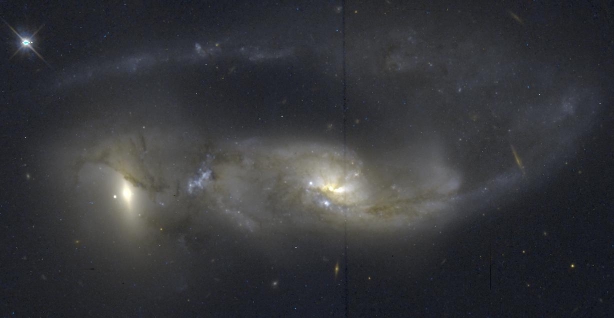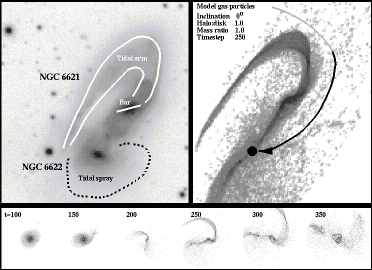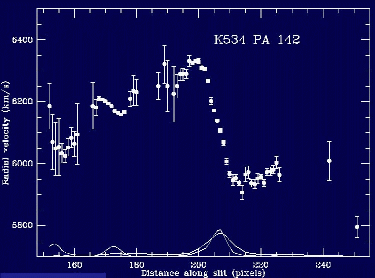

The interacting-galaxy pair 6621/2 in Draco, shown as a color composite from HST WFPC2 images. The inset is half-size; click for the full pixel scale, covering a region 64 by 123 arcseconds. This view was made from two of the four WFPC2 CCD chips. NGC 6621/2 lie about 85 megaparsecs or 280 million light-years away. This is a strongly interacting system, part of the "Toomre sequence" set out to illustrate the sequence of events during galaxy mergers (many of which appear in this montage of nearby merging systems). The structure of the system can be nicely fit from n-body simulations, as seen in this diagram from a paper with Kirk Borne which compares the model to an image from the Kitt Peak 4-meter Mayall telescope:

The larger galaxy is the very disturbed spiral NGC 6621. We view the pair about 100 million years past closest approach, in which NGC 6622 passed just at the edge of the disk of NGC 6621 in an orbit nearly parallel to the disk plane. In addition to the tidal distortion that has pulled the long tail out and wrapped it behind the main body from our vantage point, the encounter has triggered extensive star formation; this system has a richer collection of young massive star clusters than the better-known and closer Antennae, NGC 4038/9. It is especially interesting that the very compact collection of star clusters and emission nebulae between the two galaxy nuclei coincides with a region in which the dynamics of the disk are so profoundly disturbed that the slope of the velocity field changes sign, which may implicate gravitational instability within the disk (a result of tidal disturbance) as one cause of formation of such massive star clusters. This may be seen the the velocity slice below, from the Kitt Peak 2.1-meter telescope, where the reversal can be seen at x-values from about 167-175.

Thus, clusters can form quickly after a strong enough perturbation, not awaiting further churning as the galaxies come together and merge later. NGC 6622, the edge-on S0, is not escaping this encounter without change either. While it has no apparent star formation now, the corkscrew form of the dust lane crossing in front of it shows that the gas and dust are being strongly affected by its gravity and some will likely end up being transferred to the smaller galaxy, perhaps to fuel a much later episode of star formation and nuclear activity. This would then be an earlier stage in the kind of process we see going on in NGC 1409/10.
Image usage note: by NASA policy, all Hubble images are not subject to copyright (including those where the visualization comes from somewhere else than STScI). If you want to use this one and cite the source, the credit line would read W. Keel (Univ. Alabama), K. Borne (George Mason Univ.), and NASA.
Last changes: 11/2003 © 2003